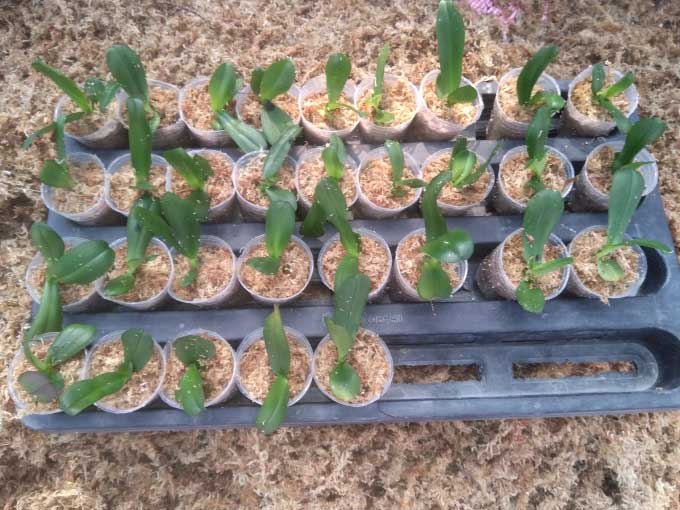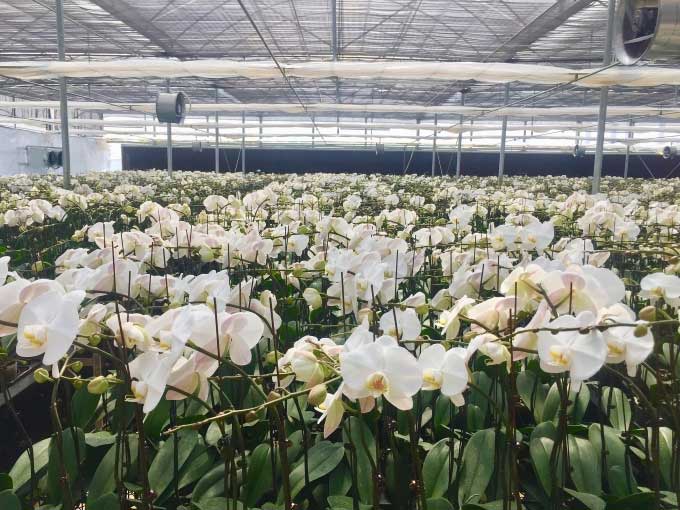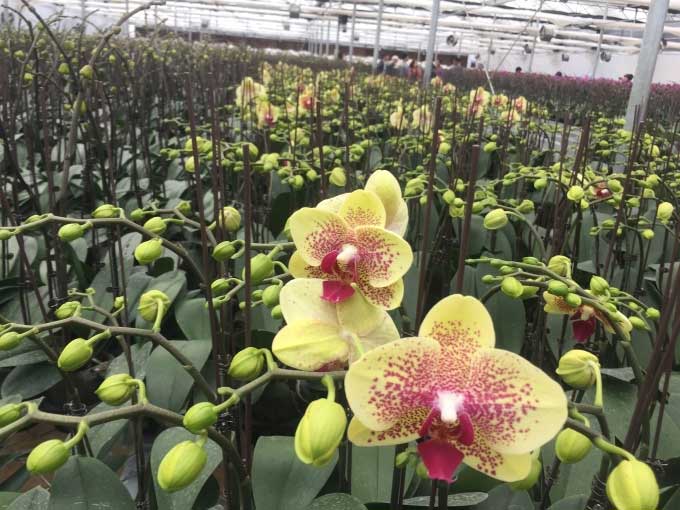The project, led by Associate Professor Dr. Lê Tất Khương, aims to establish a model for breeding and intensively cultivating Phalaenopsis orchids, delivering high economic efficiency.
Associate Professor Dr. Lê Tất Khương, former Director of the Institute of Regional Research and Development under the Ministry of Science and Technology, noted that Phalaenopsis orchids thrive in cool climates. In natural conditions, they bloom in March each year, with flowers blooming unevenly and only 35.5% of the plants flowering at once. This presents a challenge for scientists to produce a large quantity of orchids to meet the high market demand during festive seasons, while also controlling the blooming time to enhance the flower’s value.
Recognizing the economic potential of the orchid market, the research team at the Institute of Regional Research and Development studied breeding techniques and perfected the process, applying modern greenhouse technology for commercial Phalaenopsis cultivation. According to Professor Khương, the use of advanced technology, including temperature, humidity, and light sensors, helps mitigate weather-related challenges and ensures high safety.

Phalaenopsis orchids being prepared for transfer to the nursery. (Photo: Research Team)
The research team has successfully bred LVR2, LVR4, and Tiểu Kiều Tím Phalaenopsis, along with several imported varieties from Taiwan. To create a large number of seedlings, the optimal breeding technology employed is tissue culture. “Tissue culture offers the advantage of producing a large quantity of disease-free seedlings with high uniformity, meeting the quantity and quality requirements for production, and creating high-quality commercial products,” Professor Khương stated.
The team adjusted temperature and timing to precisely control the blooming date. The optimal temperature was established, maintaining 16-18 degrees Celsius at night and 20-24 degrees Celsius during the day for approximately 33 days, resulting in the highest spike emergence rate. After treatment, maintaining a stable temperature of 22-24 degrees Celsius led to good growth and development of the plants. The orchids bloomed uniformly, and the flower quality was superior compared to other timeframes and temperatures.
Thanks to the new technology, the project has established a breeding model for 30,000 orchids per year, with plant heights reaching 4-5 cm; the seedlings are then produced on a commercial scale of 20,000 plants per year, achieving 14 flowers per stem, with a minimum of 8 flowers. “Cultivating flowers in all seasons throughout the year, blooming as desired with consistent quality yields significantly higher economic returns,” Professor Khương added.
The production and trade linkage model for orchid seedlings and flowers has proven highly effective. Over three years, the project has nurtured 90,000 orchid seedlings and produced 60,000 commercial orchids for the market.

The commercial orchid cultivation model. (Photo: Research Team)
Mr. Nguyễn Văn Lam, Deputy Director of the Institute of Regional Research and Development, stated that the new technology is highly scientific and practical, increasing the economic value by 30-50% for orchid breeding. The seedlings have high uniformity and survival rates, enabling large-scale production and reducing input costs. “For commercial orchids, applying in-situ blooming treatment reduces input costs by 20%, with uniformly beautiful flowers of good quality, allowing precise control over blooming dates,” he remarked.
This is part of the results from the project “Completing and applying the process of producing seedlings, intensively cultivating avocados, grapefruits, oranges, Phalaenopsis orchids, and linking the consumption of commercial products in several northern provinces,” led by the Institute of Regional Research and Development, implemented from 2017 to December 2020. Throughout the implementation process, the project has contributed new technological advancements, including refining grafting techniques in the avocado, grapefruit, and orange breeding processes, enhancing the quality of avocados and grapefruits, while also providing development directions for fruit trees in hilly, semi-mountainous areas in the northern region. The research results contribute to transforming the crop structure towards commercial production, delivering high added value and applying advanced technology in agricultural production.
The team has also established a model for breeding avocado trees (10,000 trees per year) and grapefruit-oranges (50,000 trees per year) with high applicability in production practice. Two models of collaboration with enterprises for production and commercialization of products have been established based on these results.
“The fruit tree breeding model of the project yields over 20% higher economic value compared to the common model in the locality. The intensive cultivation model for oranges and grapefruits produces high-quality fruit, with the quantity of grade 1 fruits increasing by 25-30% compared to conventional models,” Mr. Lam further added.

The industrial production model yields uniformly beautiful flowers of good quality, with precise control over blooming dates. (Photo: Research Team).
Professor Khương indicated that based on these results, the team will continue to replicate the project model, transferring technology to farmers and enterprises in northern provinces for breeding Phalaenopsis orchids and commercial orchids, as well as for fruit trees like avocados, grapefruits, and oranges to supply the market.


















































